 Marine Francaise: c500 ships: Ironclads, Ships of the Line, Frigates, Corvettes, Bricks and Sloops
Marine Francaise: c500 ships: Ironclads, Ships of the Line, Frigates, Corvettes, Bricks and Sloops
Marine Impériale 1870: World’s second largest
The Marine Nationale (French Navy) did not existed yet in 1870 as the name was changed during the installation of the third Republic. Belonging to the Emperor Napoleon III, the French Navy of that time was nevertheless the second world’s largest, in line with grand colonial ambitions (France also had the second largest Empire behind Britain). There were two problems for it to equal -not yet surpass- the British Royal Navy: Bring its industrial power to parity, a very long way ahead as France was still largely a rural economy, and the ever-lasting problem of frontiers with potential adversaries, the more likely being Prussia and Austria-Hungary. The latter forced the use of a strong army, detrimental to the Navy, as Great Britain could divert mire funds to the Navy, including powerful Marine troops forces.
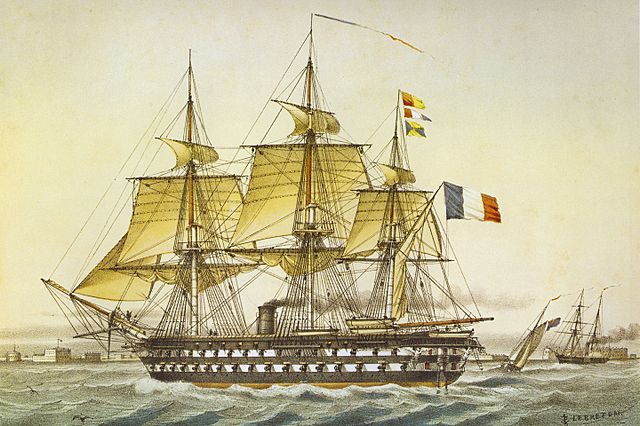
Steamship of the line Austerlitz (engraving by Lebreton).
The French Navy however at that time had everything to be satisfied. In tonnage and technology she largely dwarved any other navies in the world, being equal to the third and fourth navies combined. The Crimean war would show her opposed to the Prussian Navy, way, way below in tonnage. And indeed, fights at sea were very rare. Nonetheless in this British Century of “Pax Britannica”, it was a reminder that naval battles in Europe were quite rare. In the 1860s, at Lissa, both the Italians and Austrians fought however and south America saw one of the largest riverine battle of all times (the victory of Riachuelo). The only naval combat between France and Prussia has been a duel between the gunboats SMS Meteor and the Bouvet. Hardly a grand scale naval battle. Therefore it was of little use for naval historians of the time. But 1870 was interesting anyway for two reasons: The conversion to steam power and ironclads as the new kings of the seas.
Context: The second French Empire
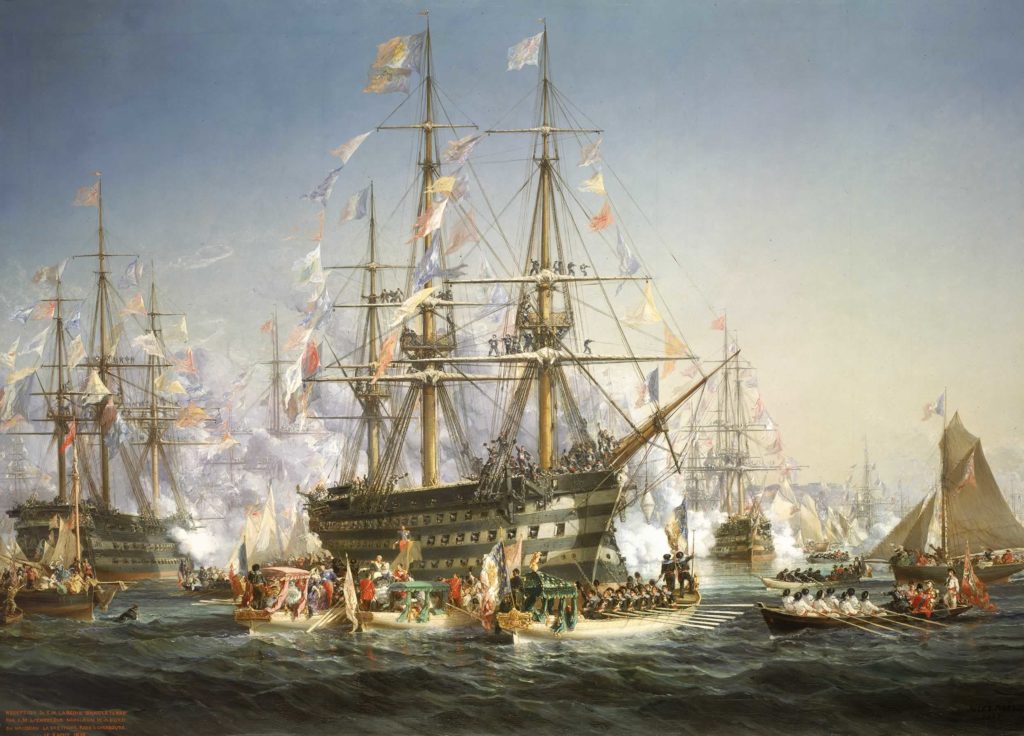
The Bretagne, 130 steamship of the line (1855), showcased in the 1859 naval review, since 1866 a training ship. Painting by Jules Achille Noël (London).
French Innovation
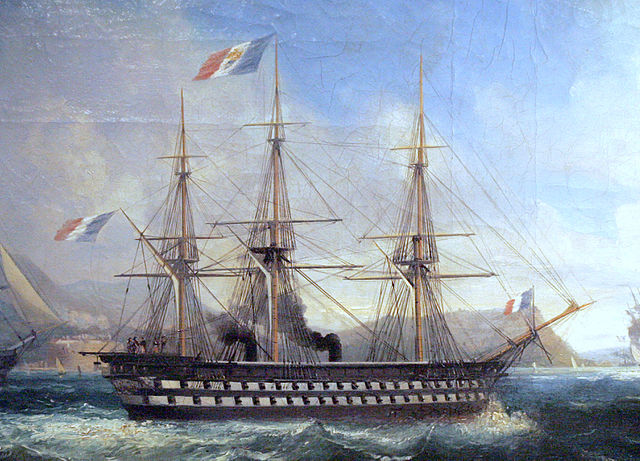
France was able to show the world in 1850 the first purpose-built steam battleship, from one of the most gifted engineers of the age: Henri Dupuy de Lôme. Showing its usefulness during the Crimean War this forced the British Empire to revise its plan and swap to steam power for all its fleet, not to be undone, while the French were equally busy converting or building new large steamship for their fleet.
In 1859, the same engineer stroke again, with a ship that resonated like a thunder-strike in the house of commons: The Gloire was a rather small wooden-hulled frigates of no importance as a warship, but she was entirely cladded in iron plates, making her impervious to cannonballs. The ironclad was born, and thus, the battleship, which would soon make obsolete all classic wooden ships-of-the-line. The idea was showcased by the Secession and Union fleets at war on the other side of the Atlantic, and again at Lissa in the Mediterranean.
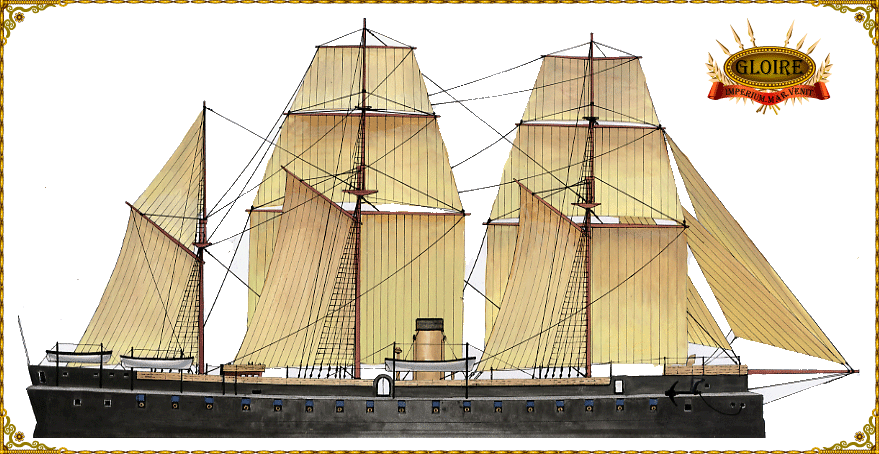
If this was not enough, Captain Siméon Bourgeois, associated with builder Charles Brun in 1863 made the first submarine in the world to be propelled by mechanical power. This made France a leader in submarine development overnight and the only field of the three the Royal Navy was slow to recognise and follow. Indeed, Great Britain was not long at converting or building in the 1850s quantities of first rank steamships, and to the Gloire, showed its industrial muscle by building not one, but a pair of giant, revolutionary ships, the first all-metal ironclads, humbling the Gloire. Nevertheless, French naval construction mass-built this model, and others behind. The Gloire was followed by two sister-ships, the Provence class in 1861, Couronne (1861) and Magenta (1861), the latter being the first two gun decks ironclads, but still, wooden-hulled. During these ten years, UK maintained its superiority both in technology and numbers.
In 1870, the French were building the Océan class ironclads. Still wooden-hulled, there were the first however with a central battery, four main guns and iron watertight bulkheads. However in August the war was lost an Napoleon III defeated, but hostilities only ended in May 1871 after negotiations led by the new Government of Adolphe Thiers and the commune in Paris, a civil war.
Also this year saw the launch of the Bélier, followed in 1871 by the Tigre and 1872 by the Bouledogue. The same year also, the French were building at Brest, Rochefort and Toulon the La Galissonière class central battery ironclads, laid down in 1868-69. These 4500-4600 tonnes vessels were less armoured and well armed than regular ironclads and has been assimilated by many authors, like the Alma that preceded them, as armoured “cruisers” though the term was not used then.
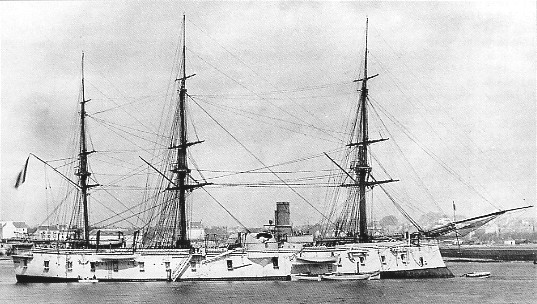
Also in 1870 were in construction a serie of 19 composite frigates, all laid down in 1866-69. These were the four Infernet class, the three Sané class, the ten Bourayne class, and Hirondelle. Ranging from 1,100 to 2,000 tonnes, they came from three Atlantic coast yards, Brest, Cherbourg, and Nantes. The Infernet were the last with a clipper bow, the following being fitted with rams. Not armoured, they counted on some large artillery pieces to take their opponents down, and speed. The Bourayne for example had a single 6.4 in BL guns, completed by 5.5 in and small 1-pdr revolver guns. Also, the French were building sloops (others would describe them as gunboats) for their colonial ports, notably the Boursaint, a modified version of the preceding Bruix (launched 1867).
They were also studying replacement for their older gunboats with the future Crocodile class, laid down after the war – The first was launched in 1873. These eight ships were better armed and had a longer range and speed. In 1875, the torpedo would enter French vocabulary and Claparède Yard would create a prototype, called “number one” in 1876. A new era started as these fast and cheap vessels were much simpler than submarines. Indeed, since the plongeur, there was no new prototype before 1888 and the all-electric Gymnôte by engineer Gustave Zédé, a quarter of a century after.
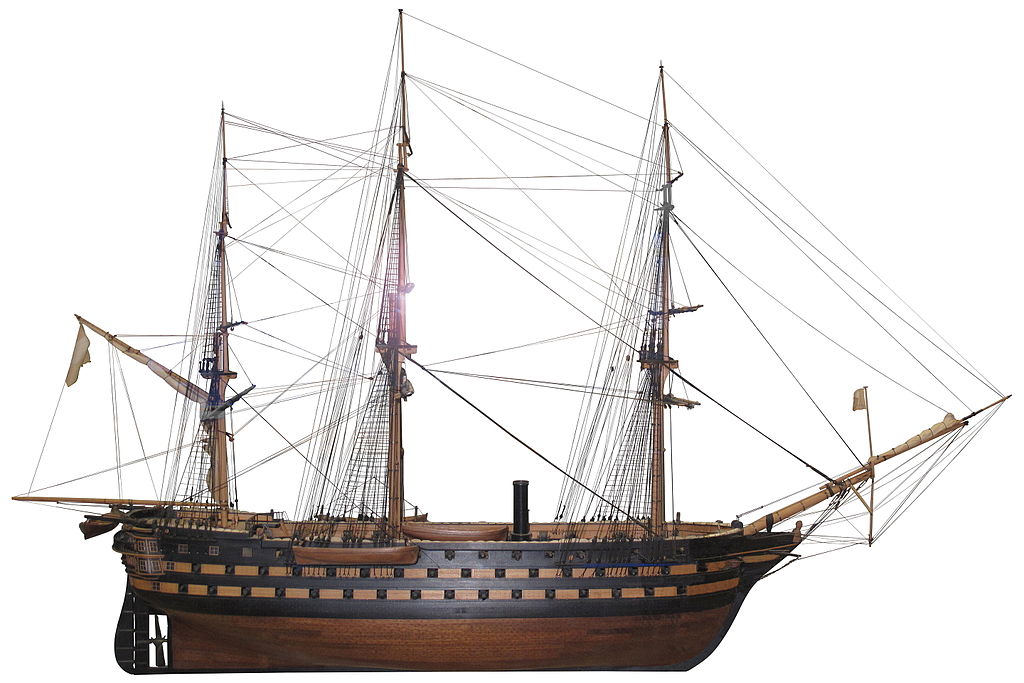
The 110-guns Hoche (ex-Prince Jérôme), steamship of the line.
The war at sea
When the Franco-Prussian war broke out on 19 July 1870, following the famously rewritten dispatch of Ems (by a shrewd Otto Von Bismarck), the Navy was mobilized as well. However there was little she could do to capitalize on her superiority.
Indeed, the French had 17 first rank ironclads (including the ex-US Rochambeau) built to boost the navy, 8 second class ironclads, 12 armored floating batteries (plus 5 older), 2 ironclad rams, 26 modern composite frigates, 8 colonial sloops, 13 gunboats, but also 3 screw three-deckers, 21 screw two-deckers, 12 screw frigates, 8 paddle frigates, 10 screw corvettes, 5 paddle corvettes, 13 screw sloops, 10 paddle sloops and 51 screw gunboats, so 219 modern screw vessels.
To this, the fleet also add at least a part of old sailing fleet (not converted, most gradually reformed after 1860): 8 ships of the line (including the 114 guns Valmy, two 90-guns, three 82 guns, one 80 and one 70 guns), 27 sailing frigates (38 to 56 guns), 12 sailing corvettes (16-22 guns), and 22 brigs, for a total of 69 sailing vessels.
This was a grand total of around 280 ships, and with transports and smaller vessels, about 470 ships in all.
Compared to this, the Prussian navy was alone (as unification of German states was not made yet, and therefore their own fleets). Only the Prussians had a considerable maritime facade.
In 1860 it had just 2 steam corvettes, 3 steam paddle frigates, 2 sailing frigates, 1 sailing corvette, 1 armed yacht, 1 transport, 2 schooners, 42 smaller sailing and rowing vessels and the Royal steamer Viktoria. In all about 55 vessels and 270 guns. However in the last decade preceding 1870, Prussian industries were building-up. In 1865 at last, Prussia took delivery of a former British ironclad ram made for the Confederates and resold after the latter lost the war: SMS Prinz Adalbert, joined in 1865 by Arminius and the French-built Friedrich Carl in 1867, the British-built Kronprinz and König Wilhelm in 1867-69, so five armoured vessels, including three large sea-going ones. The Prussian fleet also added to this 5 screw frigates and 4 screw corvettes, with more in construction, plus the 15 Jäger and 8 Chamaleon class gunboats. This made for a total of 91 vessels, which was not ridicule, but nowhere near what was necessary to beat the French at sea, despite the fact the French had spread their forces between their extensive colonial empire (notably in Chinese waters), and the main port of Brest and Toulon in the Mediterranean.
To access Prussian waters, the French needed to access the Baltic via the Skagerrak strait, guarded by neutral Denmark and watched over by Sweden and Norway as well. But they could have setup a naval blockade for the limited merchant traffic of Prussia with the rest of the world, notably the Americas. This was of limited reach, but Napoleon III took the decision to make one, inspired by many other examples, including the recent Union blockade against the Confederacy.
The North German coast was blockaded and this lasted for most of the war. The Prussian Navy could attempted to break it with its three large ironclads but they showed with engine troubles and only SMS Arminius made sorties. The French fleet was gone when at last the Prussian ironclads were in order again. The blockade was at least partially successful, but not totally due to many oversights.
Indeed, reservists of the navy that were needed in case of war were by then working in Newfoundland fisheries and Scotland. Only part of the blockading navy was ready on 24 July. Moreover, the French navy ran short of coal, with a need for 200 short tons (180 t) per day and limited bunker capacity in the fleet. Wilhelmshaven was not blockaded efficiently whereas conflicting orders for the Baltic Sea fleet made things harder. French naval efforts therefore came to nil. Coal shortages were so bad that only sailing ships could be able to chase blockade-runners, so much steamers frequent chases at the beginning of the blockade had depleted their reserves.
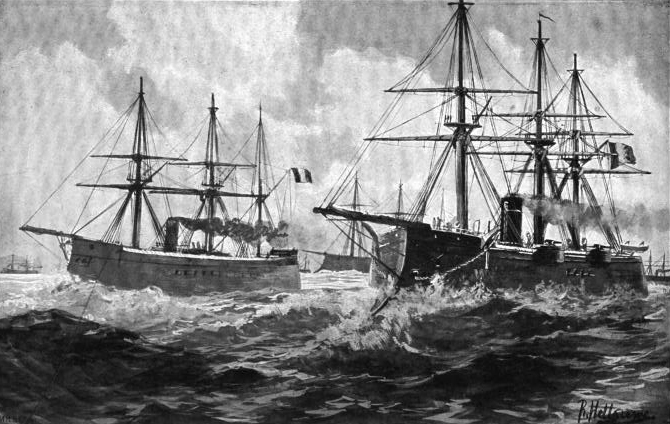
Napoleon III however had another plan for the navy. In order to relieve pressure, the high command planned a seaborne invasion of northern Germany. The French expected this invasion to relieve pressure and divert troops, but also to encourage Denmark to take a revenge and divert even more troops in this area. At the time Denmark still had about 50,000 men and sizeable Royal Danish Navy.
Alas, French intelligence was weak and it was reported later that Prussia just recently built significant defences around main North German ports, with long range, Krupp heavy coastal artillery, capable of battling French vessels at 4,000 yards (3,700 m), double the range of the best French naval guns. The French Navy was therefore found unable to engage these coastal defences. The French admiralty also argued that the German topography in this area made a seaborne invasion impossible.
In view of these developments, the plans were dropped, and French Marines and naval infantry were reallocated to to the army of Châlons. They were later captured at Sedan along with the Emperor. To compound this, most navy officers were captured like the rest of the professional French army at the Siege of Metz and later at Sedan. Naval officers indeed were recruited to command reservists of the Garde Mobile at home after the losses. Autumn storms in the North Sea also forced the return of the remainder of blockading French ships, which gradually dwindled until September 1870, where it was completed halted for the winter. The fleet therefore stayed in ports for the rest of the war.
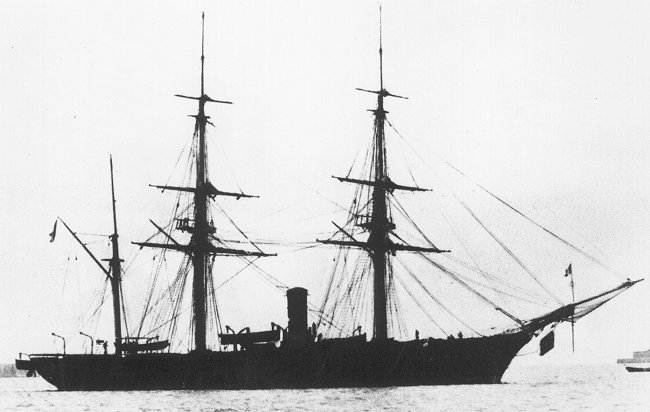
Meanwhile, in Pacific and Caribbean, the French corvette Dupleix located the German corvette SMS Hertha in Nagasaki and blockaded her for the remainder of the war, whereas at Havana the same situation took place between the Prussian gunboat SMS Meteor and the French aviso Bouvet. But this time, as both ships were of equal class, a duel was proposed, and accepted, which took place in November 1870 in Cuban waters and ideal conditions.
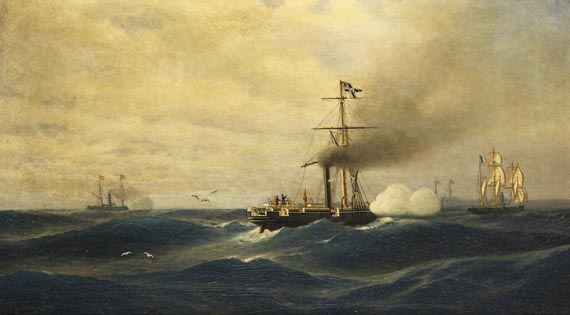
Painting of the duel of the Meteor vs Bouvet, November 1870, painted by Robert Parlow in 1892.
This was the “battle of Havana” (9 novembre 1870) which ended as a draw, and was the only fair fight between vessels of both nations at sea during this short war.
read more: https://en.wikipedia.org/wiki/Battle_of_Havana_(1870). The French however saw this as a victory since they badly damaged the Prussian ship’s rigging and in effect maintained the blockade effective until the end of the war, avoiding the latter preying on French merchant traffic.
French Ironclads 1870
Gloire class
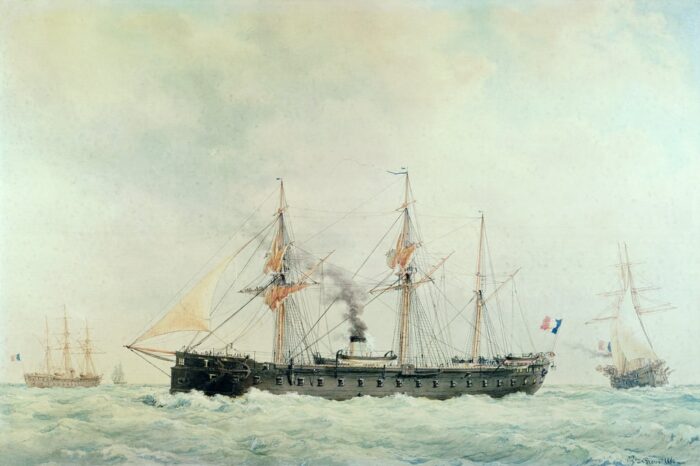
La Gloire, the first seagoing ironclad warship in the world. Built by the French Navy in 1859, La Gloire marked a turning point in naval technology and warfare, heralding the transition from wooden ships to armored, steam-powered vessels. She was made of wood but reinforced with 110 mm (4.3 inches) of wrought iron armor plates. Length was Approximately 77 meters (252 feet) for a displacement of Around 5,630 tons. She was initially equipped with 36 rifled muzzle-loading guns.
She Steam-powered with a single screw propeller with a speed of about 13 knots (24 km/h, 15 mph) and full barque rigging. Launched in 1859 she entered service in 1860. Her success prompted other nations, especially Great Britain, to develop their own ironclad fleets, such as HMS Warrior. She was was decommissioned in the late 1870s and eventually scrapped butremained an iconic symbol of naval innovation.
Couronne
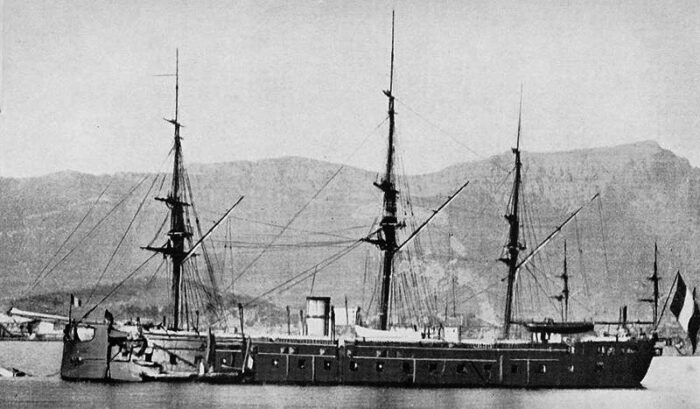
The Couronne was France’s first iron-hulled broadside ironclad warship, representing a significant step in naval engineering and marking a milestone in the evolution of French armored warships. She was constructed at the Arsenal de Lorient in Brittany, launched in 1859 and commissioned in 1862. She had a broadside battery of rifled muzzle-loading guns, arranged in a single tier along the length of the ship and was protected by iron plating approximately 120 mm thick with a CT. She was much larger than the Gloire class, about 80 meters (262 feet), a beam of 17 meters (56 feet) for a displacement of approx. 6,357 tons. Powered with a single screw propeller HTE machine she could reach 12 knots (22 km/h, 14 mph) and supplemented by a full rig of sails. She was built during a period of intense naval rivalry between France and Britain, as an answer to the Warrior class. She served for several decades before being retired as a gunnery training vessel, in 1908.
Magenta
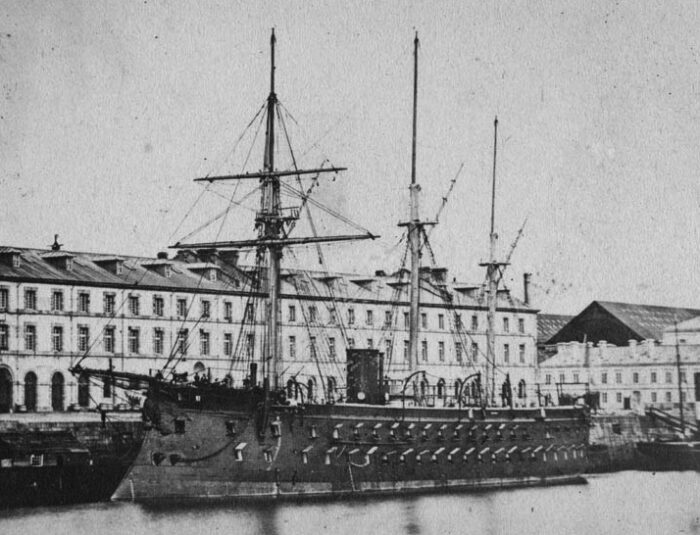
The Magenta was a French broadside ironclad warship which innovated as being the world’s first with a double battery and built-in ram, plus having a double-deck gun arrangement, making for a significant evolution in naval architecture during the ironclad era. She was built at the Arsenal de Brest, launched in 1861. She was the first, second-generation ironclad developed after Gloire and Couronne, and a step forward in ship design. She fielded 50 rifled muzzle-loading guns arranged in a broadside configuration with a part in a central battery, housing the heaviest guns (8 per side). She was also quite large, measuring 92 meters (302 feet) for 17.3 meters (57 feet) for a displacement of c6,870 tons. She had a belt and central battery of 120–130 mm of wrought iron. She had a single screw HTE steam engine, capable of 12 knots (22 km/h, 14 mph) and she had a sailing rig as backup. Despite her central citadel she still had a double-deck gun arrangement. She primarily served in the Mediterranean Squadron but her service was cut short by a tragic explosion in 1875 while docked in Toulon. She was destroyed, along with significant loss of life and a large cargo of treasures from archaeological excavations.
Provence class
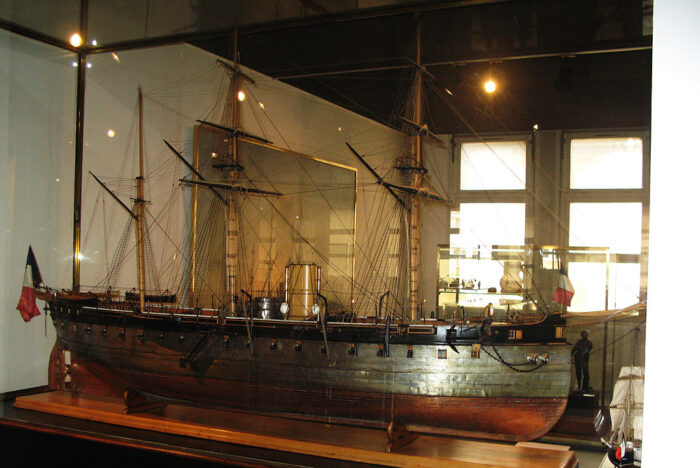
The Provence class were ten broadside ironclads built in the follow-up of the Gloire class in 1859. They were all laid down in 1961, launched 1863-65 and completed in 1865-67. They were an evolution of the earlier Gloire-class ironclads, incorporating thicker armor and heavier armament, while still having a wooden hull. They were quickly involved in the Franco-Prussian war, their major engagement, marred however by the lack of coal. The blockade of the Prussian coast, partly in the Baltic, in Danish waters and in the Heligoland bight was cut short and many gunners of these ships ended in the defense of the besieged Paris in 1871. These ironcalds then went in and out of reserve, split between the Northern and Medietrannean Squadrons, but some seeing further actions in the Levant, Tunusia, Greece among others. The last was still a utility hulk in 1901, but most had been scrapped in the 1880s after limited modernization. They still represented by their mass, ten ironclads of the same model, the bulk of the French ironclad fleet for more than a decade, alongside more fancyful and costly ships such as the Magenta class, and the rise of central battery ships.
Océan class
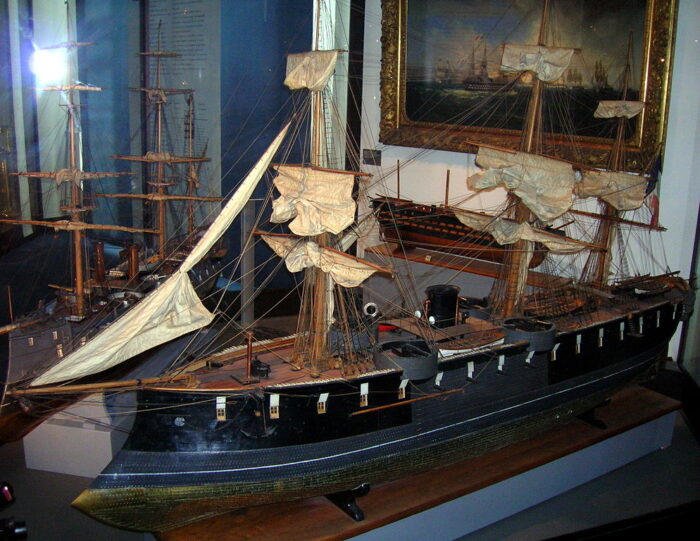
On 21 July 1870, just as the war started, the first of three ironclads of this new class was completed. The Océan-class were a class of three broadside ironclad warships built for the French Navy in the 1860s and among the most powerful warships of their time, designed to challenge the best British ironclads of the time. The class included the Océan, Marengo, and Suffren and they were designed for fleet actions, with heavy armor and firepower suitable for line-of-battle engagements. They were long at 88.6 meters (290.7 feet) and quite broad at 17.5 meters (57.4 feet) for a draught of 8.4 meters (27.6 feet and a record displacement of 7,775 tons. They were powered by a single HTE steam engine, one screw propeller, and 13 knots (24 km/h, 15 mph) and given a barque type sailing rig for long-range cruising.
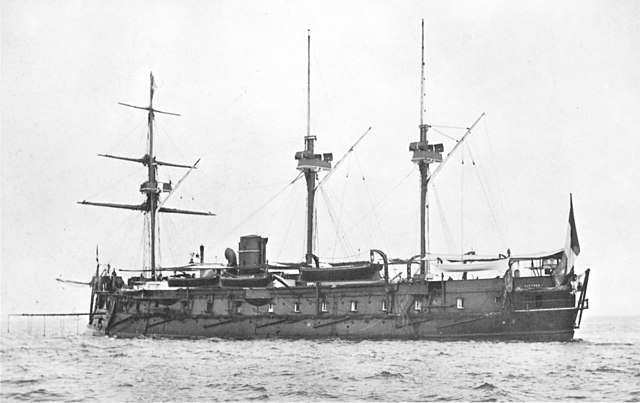
They were protected by a wrought iron armor belt, up to 220 mm (8.7 inches) thick at its strongest points. They also had their best protection at the point they carried four 240 mm (9.4-inch) Mle 1864 rifled guns in barbettes, in a central battery and six 194 mm (7.6-inch) Mle 1864 rifled guns in broadside, a significant change compared to previous designs. Still not a central battery but they can be seen as transitional. Launched in 1868-1869 and served in the Mediterranean Squadron and actived until the 1880s but became obsolete and only saw limited modernization before going into secondary roles before being scrapped.
French armoured cruisers
Belliqueuse
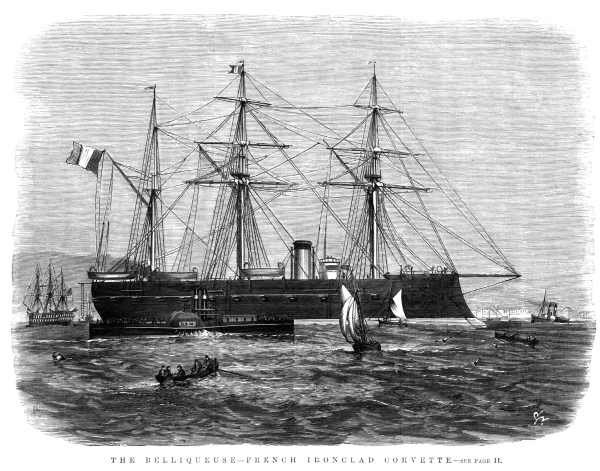
The Belliqueuse was a notable French ironclad warship, representing one of the earliest steps toward a modern armored fleet. She holds historical significance as France’s first ironclad built from the keel up, designed as a station ironclad for colonial service, rather than as a line-of-battle ship for fleet actions.
She was laid down in 1863 and launched in 1865 at the Arsenal de Lorient, designed as a smaller, less expensive ironclad, intended for operations in distant colonial waters. She was built entirely with an iron hull, 68.8 meters (226 feet) long, 13.9 meters (45.6 feet) wide, 6.3 meters (20.7 feet) deep and displacing c3,726 tons. She had a single steam HTE engine driving a screw propeller for a top speed of 11 knots (20 km/h, 12 mph). She also had a sailing rig for extended cruising range, reflecting her role as a station ironclad. She had a Wrought iron belt armor up to 120 mm (4.7 inches) thick, providing reasonable protection for her size and armed with four 194 mm (7.6-inch) rifled muzzle-loading guns on the broadside later considered light compared to larger ironclads but sufficient for her intended colonial duties. Her role was overseas colonial stations, operating in Asia, Africa, and the Americas. She had a relatively uneventful career, and primarily served as a deterrent and a symbol of French power in colonial regions. She was decommissioned in the 1880s and scrapped after being removed from active service.
Alma class
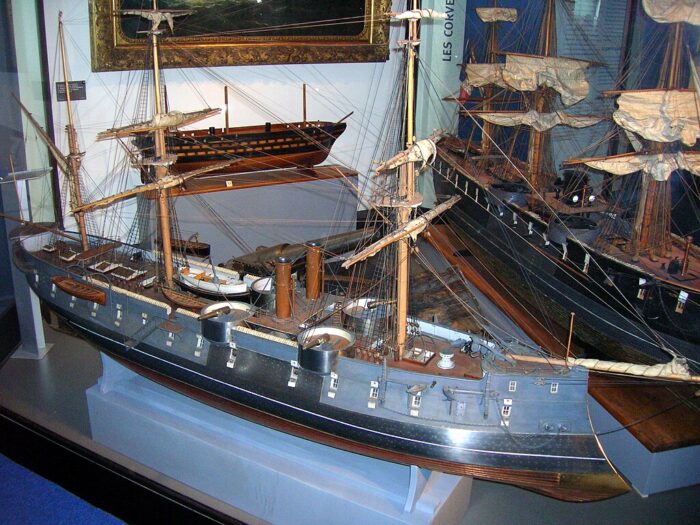
Class: Alma, Thétis, Reine Blanche, Jean Bart, Belliqueuse, Artémise, Gauloise, Provence, Louise-Marie, Sémiramis
The Alma-class ironclads were a group of wooden-hulled, armored frigates built for the French Navy in the 1860s. Designed as station ironclads, these ships were smaller than fleet ironclads like the Océan class and intended for colonial duties or coastal defense. The class consisted of 10 ships, built between 1865 and 1867. They were designed as broadside ironclads with iron armor plates over a wooden hull. Their smaller size and relatively modest armament made them well-suited for station duties in colonial waters but less effective in large fleet engagements. They measured 66.8 meters (219 feet), while being 14 meters (46 feet) wide, with a draught of 6.3 meters (20.7 feet) and she displaced 3,570 tons.
She had single steam engine driving a screw propeller, capable of 11.5 knots (21.3 km/h, 13.2 mph) and with a sailing rig, they were long-range station ironclads.
They were protected by Wrought iron belt armor up to 120 mm (4.7 inches) thick, focusing on the waterline and machinery spaces.
They were armed with four 194 mm (7.6-inch) rifled muzzle-loading guns in broadside and light vessels or shore bombardments in colonial settings.
They were primarily used as station ironclads in colonial waters and for coastal defense suppressing rebellions, and supporting expeditionary operations. They served during a period of relative peace for France, so they saw little combat and were eventually relegated to secondary roles, such as training or harbor duties. They were decommissioned between the late 1870s and 1890s.
French Coast Defence ships 1870
Palestro class
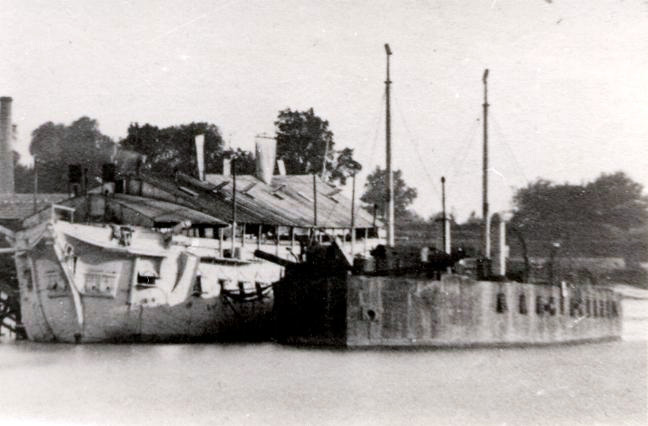
Class: Palestro, Pei-ho, Saigon, Paixhans
The Palestro-class were built at Arman, Bordeaux, started in 1859, launched August 1862. Ironclad floating batteries were a pair of heavily armored, coastal defense warships built by France in the 1850s. These vessels were designed during the Crimean War (1853–1856) for use against Russian fortifications and represented an early step in the development of armored naval vessels. They were designed as floating batteries to bombard coastal fortifications, particularly during amphibious operations and for static, close-range engagements rather than fleet actions or high-seas operations.
They were Wooden-hulled ships with iron armor plating for protection, built rapidly to address immediate wartime needs, reflecting their specialized role.
They measured 50.0 m (164 feet) long, 13.75 meters (45 feet) wide, for a draft of 5.4 meters (17.7 feet), displacing 1,400 tons.
They had a single steam engine driving a screw propeller for 4 knots (7.4 km/h, 4.6 mph) protected by Wrought iron armor plating up to 120 mm (4.7 inches) thick. They were armed with rifled and smoothbore muzzle-loading guns on deck or fixed broadside positions. Later they obtained heavy-caliber guns for bombarding coastal defenses. They famously replace the Devastation class deployed during the Crimean War, shelling the coastal defenses at Kinburn in 1855. Their armor allowed them to endure heavy fire while delivering sustained bombardment, proving their effectiveness in their intended role. They were decommissioned and scrapped from 1871.
Arrogante class
Embuscade class
Taureau (ironclad ram)
Cerbère class ironclad rams
French composite frigates 1870
Armorique class
Cosmao class
Talisman
Résolue
Vénus class
Decrès
Desaix
Chateaurenault
Linois
Limier class
French corvettes & gunboats 1870
Curieux class sloops
Adonis class sloops
Guichen class sloops
Renard
Bruix class sloops
Pique class gunboats
Etendard class gunboats
Read More:
R. Gardiner Conway’s all the world’s fighting ships 1860-1905
//en.wikipedia.org/wiki/Battle_of_Havana_(1870)
//en.wikipedia.org/wiki/Franco-Prussian_War
//en.wikipedia.org/wiki/List_of_ships_of_the_line_of_France

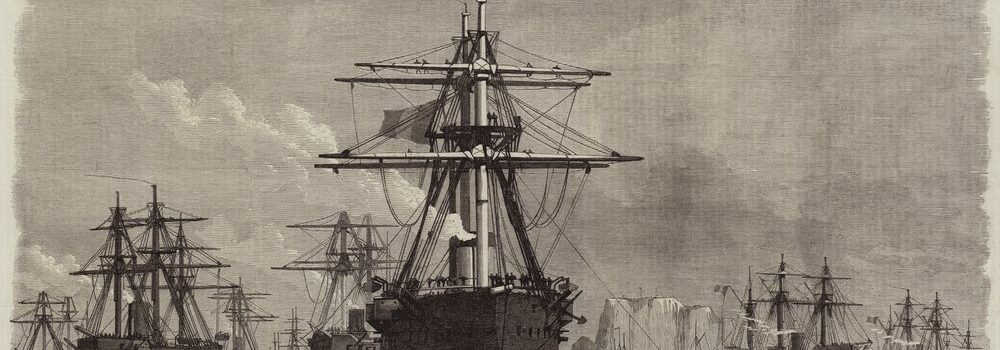
 Latest Facebook Entry -
Latest Facebook Entry -  X(Tweeter) Naval Encyclopedia's deck archive
X(Tweeter) Naval Encyclopedia's deck archive Instagram (@navalencyc)
Instagram (@navalencyc)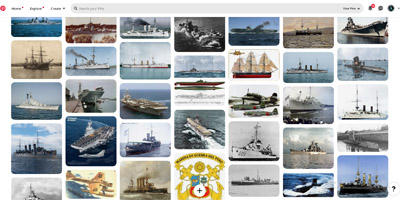


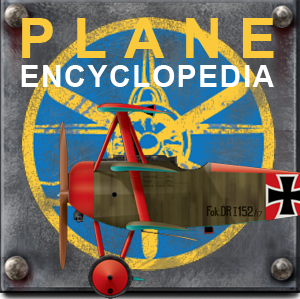
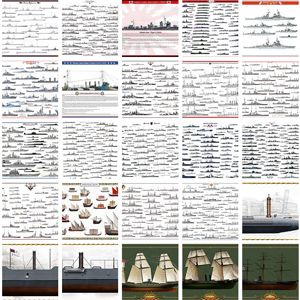
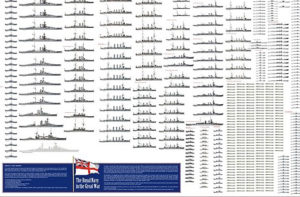
 French Navy
French Navy Royal Navy
Royal Navy Russian Navy
Russian Navy Armada Espanola
Armada Espanola Austrian Navy
Austrian Navy K.u.K. Kriegsmarine
K.u.K. Kriegsmarine Dansk Marine
Dansk Marine Nautiko Hellenon
Nautiko Hellenon Koninklije Marine 1870
Koninklije Marine 1870 Marinha do Brasil
Marinha do Brasil Osmanlı Donanması
Osmanlı Donanması Marina Do Peru
Marina Do Peru Marinha do Portugal
Marinha do Portugal Regia Marina 1870
Regia Marina 1870 Nihhon Kaigun 1870
Nihhon Kaigun 1870 Preußische Marine 1870
Preußische Marine 1870 Russkiy Flot 1870
Russkiy Flot 1870 Svenska marinen
Svenska marinen Søværnet
Søværnet Union Navy
Union Navy Confederate Navy
Confederate Navy Armada de Argentina
Armada de Argentina Imperial Chinese Navy
Imperial Chinese Navy Marinha do Portugal
Marinha do Portugal Mexico
Mexico Kaiserliche Marine
Kaiserliche Marine 1898 US Navy
1898 US Navy Sovietskiy Flot
Sovietskiy Flot Royal Canadian Navy
Royal Canadian Navy Royal Australian Navy
Royal Australian Navy RNZN Fleet
RNZN Fleet Chinese Navy 1937
Chinese Navy 1937 Kriegsmarine
Kriegsmarine Chilean Navy
Chilean Navy Danish Navy
Danish Navy Finnish Navy
Finnish Navy Hellenic Navy
Hellenic Navy Polish Navy
Polish Navy Romanian Navy
Romanian Navy Turkish Navy
Turkish Navy Royal Yugoslav Navy
Royal Yugoslav Navy Royal Thai Navy
Royal Thai Navy Minor Navies
Minor Navies Albania
Albania Austria
Austria Belgium
Belgium Columbia
Columbia Costa Rica
Costa Rica Cuba
Cuba Czechoslovakia
Czechoslovakia Dominican Republic
Dominican Republic Haiti
Haiti Hungary
Hungary Honduras
Honduras Estonia
Estonia Iceland
Iceland Eire
Eire Equador
Equador Iran
Iran Iraq
Iraq Latvia
Latvia Liberia
Liberia Lithuania
Lithuania Mandchukuo
Mandchukuo Morocco
Morocco Nicaragua
Nicaragua Persia
Persia San Salvador
San Salvador Sarawak
Sarawak Uruguay
Uruguay Venezuela
Venezuela Zanzibar
Zanzibar Warsaw Pact Navies
Warsaw Pact Navies Bulgaria
Bulgaria Hungary
Hungary

 Bundesmarine
Bundesmarine Dutch Navy
Dutch Navy Hellenic Navy
Hellenic Navy Marina Militare
Marina Militare Yugoslav Navy
Yugoslav Navy Chinese Navy
Chinese Navy Indian Navy
Indian Navy Indonesian Navy
Indonesian Navy JMSDF
JMSDF North Korean Navy
North Korean Navy Pakistani Navy
Pakistani Navy Philippines Navy
Philippines Navy ROKN
ROKN Rep. of Singapore Navy
Rep. of Singapore Navy Taiwanese Navy
Taiwanese Navy IDF Navy
IDF Navy Saudi Navy
Saudi Navy Royal New Zealand Navy
Royal New Zealand Navy Egyptian Navy
Egyptian Navy South African Navy
South African Navy






























 Ukrainian Navy
Ukrainian Navy dbodesign
dbodesign